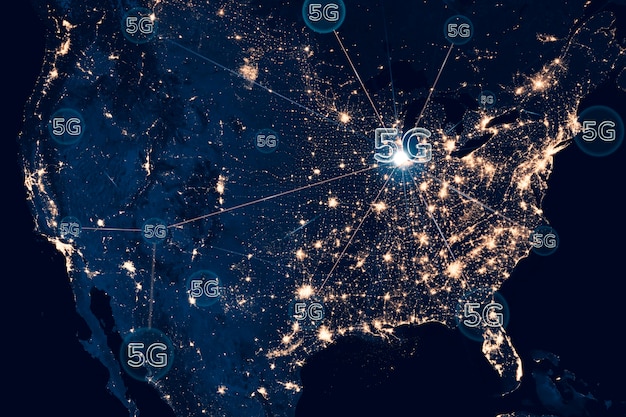Decoding 5G: Impact of Spectrum Auctions on US Mobile Users in 2025

Decoding 5G involves understanding how recent spectrum auctions will shape the mobile experience for US users in 2025, impacting network speeds, coverage, and competition among providers.
Get ready to dive into the future of mobile connectivity! What does decoding 5G: What the Latest Spectrum Auctions Mean for US Mobile Users in 2025 actually entail for you?
Understanding 5G Spectrum Auctions
5G spectrum auctions are critical events that determine which companies have the rights to use specific radio frequencies for their 5G networks. These auctions allocate spectrum licenses to mobile carriers, influencing the deployment and performance of 5G services across the nation. Let’s delve deeper into what makes these auctions so important.
What is Spectrum?
Spectrum refers to the range of radio frequencies used for wireless communication. These frequencies are a finite resource, and governments regulate their use to prevent interference and ensure efficient allocation. The Federal Communications Commission (FCC) in the US is responsible for managing and auctioning spectrum.
How Auctions Work
During a spectrum auction, mobile carriers bid for licenses to use specific frequencies in defined geographic areas. The FCC sets the rules and procedures for these auctions, which often involve multiple rounds of bidding. The goal is to allocate spectrum to the companies that value it most highly, promoting competition and innovation.

Here are some key points about how these auctions work:
- Bidding Process: Carriers submit bids for specific spectrum licenses, and the FCC evaluates these bids based on predefined criteria.
- License Types: Licenses can be for specific frequencies, geographic areas, and durations, providing flexibility for carriers to tailor their network deployments.
- Auction Rules: The FCC sets rules to prevent collusion and ensure fair competition, promoting a level playing field for all participants.
In conclusion, understanding spectrum auctions is essential for grasping the future of 5G in the US. These auctions determine which companies control the essential frequencies needed for network deployment, driving competition and innovation.
The Players: Key Mobile Carriers in the US
The US mobile market is dominated by a few major players: Verizon, AT&T, and T-Mobile. These companies have been actively participating in 5G spectrum auctions to expand their network capabilities and improve service offerings. Let’s take a closer look at each of them.
Verizon
Verizon has been a leader in 5G deployment, focusing on ultra-wideband technology for high-speed data services. The company has invested heavily in spectrum licenses to enhance its network capacity and coverage.
AT&T
AT&T is another major player in the 5G market, offering a mix of low-band, mid-band, and high-band 5G services. The company aims to provide nationwide 5G coverage and has been strategically acquiring spectrum licenses to support its goals.
T-Mobile
T-Mobile has emerged as a strong competitor in the 5G arena, leveraging its acquisition of Sprint to gain access to valuable mid-band spectrum. The company emphasizes its 5G network’s breadth and depth, aiming to deliver a superior user experience.

Here are some key strategies and investments these carriers are making:
- Verizon: Focusing on high-band spectrum for densely populated areas, offering ultra-fast speeds.
- AT&T: Balancing coverage and speed with a mix of low-band and mid-band spectrum.
- T-Mobile: Leveraging mid-band spectrum for a blend of coverage and performance.
In summary, the US mobile market is highly competitive, with Verizon, AT&T, and T-Mobile vying for dominance in the 5G landscape. Their investments in spectrum and network infrastructure will shape the future of mobile services for US consumers.
Impact on Network Speed and Coverage
The outcome of spectrum auctions directly affects the network speed and coverage available to US mobile users. Different spectrum bands offer varying characteristics, influencing the performance and reach of 5G networks. Understanding these impacts is crucial for assessing the user experience.
High-Band Spectrum (mmWave)
High-band spectrum, also known as millimeter wave (mmWave), provides the fastest 5G speeds but has limited coverage. It is best suited for dense urban areas where high capacity is needed.
Mid-Band Spectrum
Mid-band spectrum offers a balance of speed and coverage, making it ideal for widespread 5G deployment. It provides a significant upgrade over 4G LTE in terms of both speed and capacity.
Low-Band Spectrum
Low-band spectrum offers the broadest coverage but the slowest speeds. It is useful for extending 5G coverage to rural areas and providing basic connectivity.
Here’s an overview of how each spectrum band impacts network performance:
- mmWave: Ultra-fast speeds, limited coverage, best for dense urban areas.
- Mid-Band: Good balance of speed and coverage, suitable for widespread deployment.
- Low-Band: Broad coverage, slower speeds, useful for rural areas.
To conclude, the spectrum bands acquired by mobile carriers in auctions will determine the speed and coverage of their 5G networks. This, in turn, will affect the user experience, with some areas enjoying ultra-fast speeds and others benefiting from broader coverage.
Pricing and Competition in the 5G Era
Spectrum auctions play a crucial role in shaping pricing and competition within the 5G market. The availability of spectrum licenses can enable new entrants to compete with established carriers, driving down prices and improving service offerings. Let’s explore the dynamics of pricing and competition in the 5G era.
Increased Competition
Auctions that encourage participation from multiple bidders can lead to increased competition, as carriers vie for valuable spectrum licenses. This competition can result in more affordable 5G plans and better service quality.
Pricing Strategies
Carriers adopt different pricing strategies based on their spectrum holdings and network capabilities. Some may offer premium plans with faster speeds and higher data caps, while others may focus on providing more affordable options with basic 5G connectivity.
Consumer Benefits
Ultimately, increased competition and diverse pricing strategies benefit consumers by providing them with more choices and better value for their money. Consumers can select plans that best suit their needs and budget.
Here’s how spectrum auctions impact pricing and competition:
- More Bidders: Encourages competition and drives down prices.
- Diverse Strategies: Leads to varied pricing plans and service offerings.
- Consumer Choice: Provides consumers with options that match their needs.
In conclusion, the outcomes of spectrum auctions influence pricing and competition in the 5G market, creating a dynamic environment that ultimately benefits consumers through increased choice and better value.
Technological Advancements Driven by 5G
5G technology is not just about faster download speeds; it’s a catalyst for numerous technological advancements across various industries. The capabilities of 5G networks are enabling new applications and innovations that were previously impossible. Let’s explore some of the key technological advancements driven by 5G.
Internet of Things (IoT)
5G’s high speed and low latency make it ideal for supporting the Internet of Things (IoT), enabling massive connectivity for devices such as sensors, smart appliances, and autonomous vehicles.
Autonomous Vehicles
Autonomous vehicles rely on real-time data processing and communication, which 5G networks can provide. The technology enables vehicles to communicate with each other and with infrastructure, improving safety and efficiency.
Augmented Reality (AR) and Virtual Reality (VR)
5G’s high bandwidth supports immersive AR and VR experiences, enabling new applications in gaming, education, and remote collaboration. The technology enhances user engagement and interactivity.
Here are some specific advancements that 5G is driving:
- IoT: Massive connectivity for smart devices and sensors.
- Autonomous Vehicles: Real-time data processing for safer and more efficient transportation.
- AR/VR: Immersive experiences for gaming, education, and collaboration.
In summary, 5G technology is a transformative force, driving technological advancements across various industries. Its high speed, low latency, and massive connectivity are enabling new applications and innovations that will shape the future of technology.
Looking Ahead: 5G in 2025 and Beyond
As we look ahead to 2025 and beyond, the impact of 5G spectrum auctions will become increasingly evident. The decisions made today will shape the 5G landscape for years to come, influencing network performance, competition, and technological innovation. Let’s explore what we can expect in the future.
Enhanced Network Capabilities
By 2025, we can anticipate significant improvements in network capabilities, with faster speeds, broader coverage, and lower latency. These enhancements will enable new applications and services that rely on high-performance connectivity.
Increased Competition
The competitive landscape is likely to evolve as new players emerge and established carriers adapt to the changing market dynamics. This increased competition should lead to more affordable and innovative 5G offerings for consumers.
Technological Innovations
5G will continue to drive technological innovations across various industries, from IoT and autonomous vehicles to AR/VR and healthcare. These advancements will transform the way we live and work.
Here’s what to expect as we move towards 2025:
- Network Enhancements: Faster speeds, broader coverage, and lower latency.
- Competitive Market: More players and innovative 5G offerings.
- Technological Advancements: Transformation of industries through 5G applications.
In conclusion, the future of 5G is bright, with ongoing spectrum auctions playing a critical role in shaping the network landscape. As we move towards 2025 and beyond, we can anticipate significant advancements in network capabilities, increased competition, and transformative technological innovations.
| Key Point | Brief Description |
|---|---|
| 📶 Spectrum Auctions | Allocate frequencies for 5G networks. |
| 🚀 Network Speed | Impacted by spectrum band (high, mid, low). |
| 💰 Pricing & Competition | Auctions shape market prices and rivalry. |
| 🚗 Technological Advancements | Enable IoT, autonomous vehicles, and AR/VR. |
Frequently Asked Questions (FAQ)
▼
5G spectrum auctions allocate licenses to mobile carriers, enabling them to use specific radio frequencies for their 5G networks. This ensures efficient use of spectrum and promotes competition.
▼
High-band spectrum offers fast speeds but limited coverage, mid-band provides a balance of speed and coverage, and low-band offers broad coverage with slower speeds.
▼
The key players include Verizon, AT&T, and T-Mobile, each investing in spectrum licenses to enhance their network capabilities and service offerings across the US.
▼
Auctions can increase competition by allowing new entrants, leading to more affordable 5G plans and diverse service offerings that benefit consumers.
▼
5G supports IoT, autonomous vehicles, and AR/VR by providing high speed, low latency, and massive connectivity, enabling new applications and innovations.
Conclusion
In conclusion, decoding 5G: What the Latest Spectrum Auctions Mean for US Mobile Users in 2025 involves understanding the dynamics of spectrum allocations, the strategies of major carriers, and the impact on network performance and technological innovation. As we move forward, these auctions will continue to shape the 5G landscape, driving advancements and enhancing the mobile experience for users across the United States.



![Quantum Computing for Beginners: A US Geek's Guide [2025] Quantum Computing for Beginners: A US Geek's Guide [2025] - Cover Image](https://dorama2you.com/wp-content/uploads/2025/06/dorama2you.com_3_1749769492_79bdbcc1_cover-360x180.jpg)
